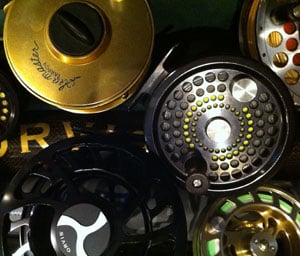All About Anodized Reels
Have a question you want answered? Email it to us at [email protected].
Question: I notice that most reel companies make a big deal out of the fact that their reels are anodized, sometimes even mentioning the “type” of anodizing. What exactly is it, and why should I care?
via email
Answer: Anodizing is a chemical process that creates a coating on the surface of a metal (usually aluminum), which makes the metal more durable and resistant to scratches and dings. Anodizing also increases corrosion resistance and makes the metal easier to dye. Reel manufacturers use aluminum because it is so light, but it’s also quite soft. Without anodizing, an aluminum reel would not be very durable.
 The most common method of anodizing involves dipping the aluminum in sulfuric acid and then running electrical current through the acid. This causes aluminum oxide to form on the surface. Unlike iron oxide—which we call “rust”—the aluminum oxide does not flake off and is, in fact considerably harder than bare aluminum. Because this film of aluminum oxide is somewhat porous, it can be dyed or painted various colors.
The most common method of anodizing involves dipping the aluminum in sulfuric acid and then running electrical current through the acid. This causes aluminum oxide to form on the surface. Unlike iron oxide—which we call “rust”—the aluminum oxide does not flake off and is, in fact considerably harder than bare aluminum. Because this film of aluminum oxide is somewhat porous, it can be dyed or painted various colors.
Fly reels generally come in Type II, although a few may feature Type III anodizing. (Type III is also known as “hard anodizing.”) The “Type” describes the thickness and consequent hardness of the coating. Type II anodizing creates a coating of less than .001 inches, while Type III describes anything between .001 inches and .004 inches. Manufacturers claim that Type III anodizing “penetrates” the metal, as well as coating it, but all anodizing methods penetrate to a certain degree.
“If Type III is thicker and harder,” you may ask, “why not make all reels with Type III anodizing?” First of all, the hard-anodizing process is much more complicated, involving colder temperatures, more electrical current, and an electrolyte solution. This is more expensive, so it adds cost to the reel. Hard anodizing is also considerably less porous, so it doesn’t accept dye as well. This is why Type III reels are available in black or dark gray only. From a marketing standpoint, hard-anodized reels are a tough sell because they aren’t shiny; the finish is more matte than Type II.
It’s important to note, however, that not all anodizing is the same. There is a wide variation in quality and hardness even within a “type,” depending on the specific process, the ingredients of the electrolyte solution, and the length of time the aluminum is subjected to current. According to Orvis’s Jim Lepage, the vast majority of reels on the market feature anodizing in the low to mid-range of hardness for the type. The harder the coating the less shiny the finish the manufacturer can achieve through the polishing process. And no matter how sophisticated we think we are, market research proves that shiny sells.











